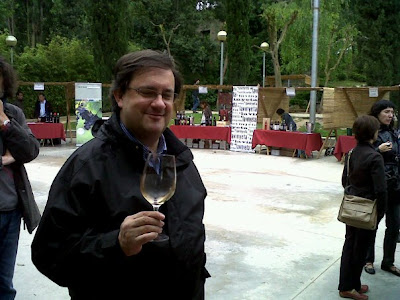Jaume Balaguer (Lo Jaume, The Jaume (James) in Western Catalan parlance) is a many faceted man. He runs Bonviure, a wine and delicatessen shop in Gratallops (Priorat), and Celler Balaguer Cabré, a boutique winery in the same village; helps in Piró, the family restaurant; and sells to restaurants and wine shops wines from a number of small Catalan wineries. Apart from these trifling tasks, he writes a blog and is great in proposing wine-food pairings. What he does in his spare time, such as it may be, is something I have never dared to ask him.
It is about this last capacity that I wanted to tell you about. After the Tast amb Llops, my wife and I attended a pairing in his restaurant. By (lucky) chance, a few days later I enjoyed a similar occasion in a restaurant in Barcelona. That will come in my next post, to allow proper labelling of wines tasted.
Piró is a restaurant serving mainly typical Catalan food. As you know, I do not comment on a restaurant’s food unless I am disappointed. This was not the case.
The wines we tasted were the following:
Les Brugueres 2009 is a 100% Garnatxa blanca white from La Conreria de Scala Dei, DOQ Priorat, with a light golden yellow colour. Intense in the nose, with white fruit notes. Well structured in the mouth, with good acidity, and very long.
Humilitat 2008 is a red coupage of Garnatxa and Carinyena, produced by vino, amor y fantasia. Medium bodied, with lighter colour and spicy nose, its winemakers claim to have produced “the Burgundy of Priorat”. Quite true, although not a Grand Cru.
Trio Infernal 1/3 2007 is a Priorat red from 60% Garnatxa and 40 % Carinyena by Trio Infernal. Black fruit, complex nose, powerful but fine tannins.
Petit Gènesi 2009, Garnatxa, Carinyena and Syrah coming from the Vermunver winery in DO Montsant. With six months in different oaks, the nose points to black fruit and balsamic notes. Fresh in the mouth, with adequate structure.
Last but not least, La Guinardera 2006 is a 100% Garnatxa from Celler Balaguer Cabré, owned by Lo Jaume. This is no nepotism; La Guinardera is an elegant, medium bodied wine that comes from the property of the same name, an old vine plot that receives sunshine the whole day. Red fruit in the nose, with tobacco notes. Silky and long.
A perfect end for a day that included the visit to the Falset Wine Exhibition and the Tast amb Llops. Ten days later I was to have another pairing with Lo Jaume; and I was indeed looking forward to it.
http://cellerbalaguercabre.blogspot.com/
















